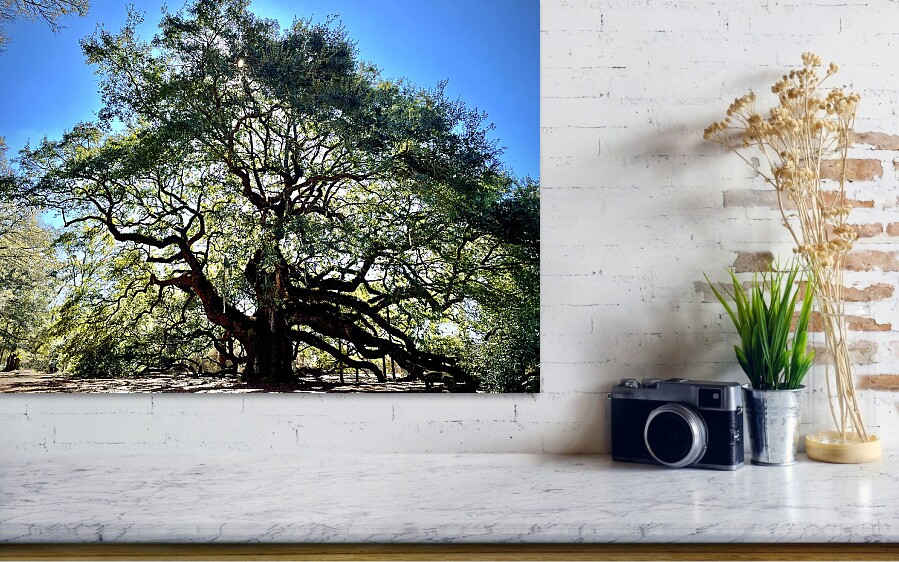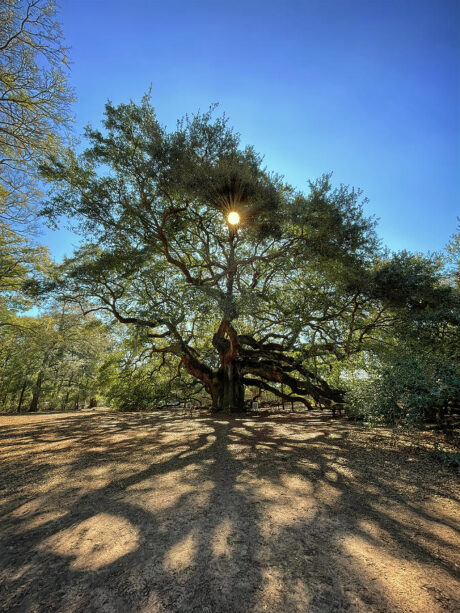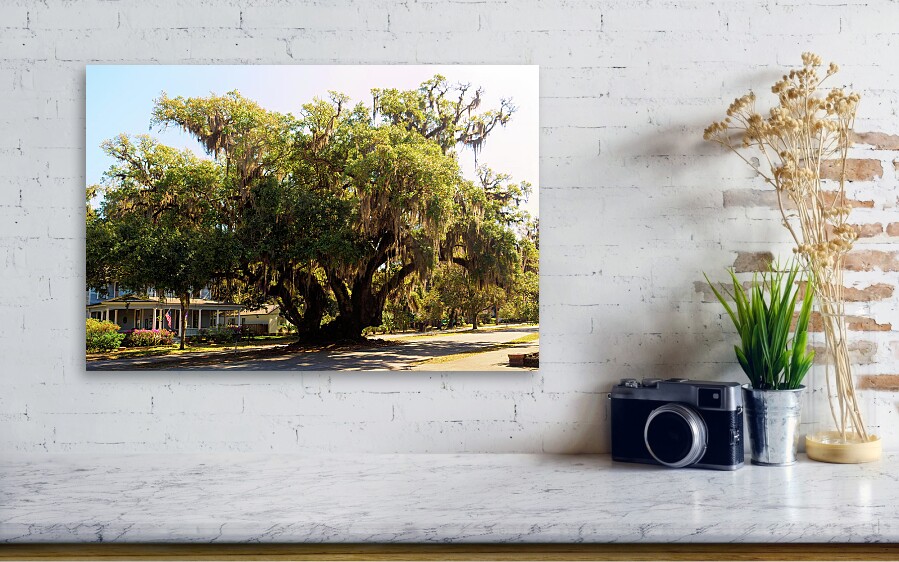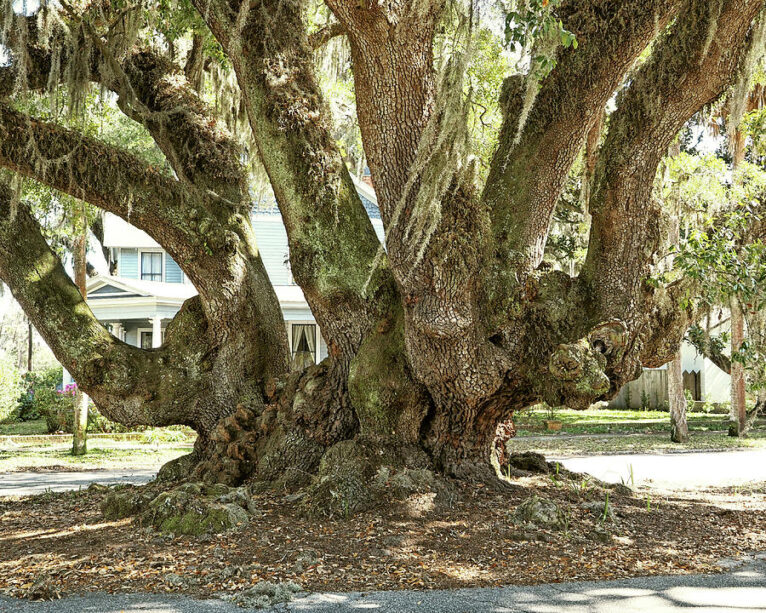The Angel Oak near Charleston, SC and the Lover’s Oak in Brunswick, GA
Imagine walking through a verdant forest alive with the majestic presence of Southern live oak trees. Among them stands the iconic Angel Oak, reaching towards the sky with its sprawling branches that seem to whisper secrets of centuries past. Each twist and turn in its gnarled trunk tell a story of resilience and endurance, inviting admiration from all who gaze upon its grandeur.
In another corner of the South, standing stately on a boulevard in a sleepy neighborhood in Brunswick, Georgia, stands the enchanting Lovers Oak. Legend has it that this ancient tree holds magical powers, granting eternal love to those who profess their commitment beneath its leafy canopy. Couples flock to bask in the romantic ambiance and make vows under its arching branches, binding their hearts together as they become part of the enduring legacy of this remarkable Southern live oak.
The southern live oak, Quercus virginiana, is an evergreen oak tree endemic to the Southeastern United States.
Marvels of Nature and History
In the tapestry of natural and historical wonders that adorn the American South, two arboreal titans stand out, weaving tales of love, resilience, and awe into the hearts of those who visit them. The Angel Oak near Charleston, South Carolina, and the Lover’s Oak in Brunswick, Georgia, are not merely trees; they are living monuments to history’s whispers and nature’s unfathomable power to enchant. These centuries-old sentinels have stood witness to the evolving landscapes around them—surviving storms and human endeavors alike—each with a story so compelling it seems lifted from myth.
The magic of these trees lies not just in their age or size but in their ability to connect us across time—to generations long past—and remind us of nature’s capacity for beauty and endurance. Where the Angel Oak spreads its gnarled branches like wings poised for flight, embodying strength and shelter over its Charleston domain, its Georgian counterpart weaves a different spell. The Lover’s Oak has branched out as if tracing invisible paths between hearts across ages with interlocking limbs that speak of entwined destinies. Here is where legend breathes life into roots deeply entrenched in Southern soil: each visit promises a sensory journey through layers of history under canopies vast enough to house countless stories yet told.
The Angel Oak: A Testament to Time
Stepping into the presence of the Angel Oak, located on Johns Island near Charleston, South Carolina, one can’t help but feel a profound sense of entering a living cathedral. This majestic tree, with its sprawling branches and ancient bark, whispers tales of ages past. Its age is estimated to be between 400 to 500 years old, making it not just a natural wonder but also a testament to time itself. Each crevice in its bark and twist in its limbs tells a story of resilience, survival, and majesty.
What sets the Angel Oak apart is not just its remarkable age or impressive stature; it’s the aura of serenity that envelops you as you stand beneath its expansive canopy. The tree measures 66.5 feet tall and boasts an astonishing shade coverage area that spans about 17,200 square feet. Scientists and poets alike have marveled at this oak’s endurance through hurricanes, lightning strikes, and human encroachment—a symbolic guardian of history that connects us to previous generations who stood beneath its outstretched limbs in awe. In visiting the Angel Oak, one cannot help but ponder on nature’s quiet strength amidst chaos—reminding us of continuity in an ever-changing world.
Historical Significance of the Angel Oak
Nestled on Johns Island near Charleston, South Carolina, the Angel Oak stands as a majestic testament to nature’s awe-inspiring resilience and beauty. This grand tree, whose sprawling limbs stretch out as if in an embrace, is not just a natural wonder but also a silent witness to centuries of history. Estimated to be up to 400-500 years old, its very fibers are intertwined with the fabric of America’s past, providing an unparalleled connection to the early days of our nation.
The historical significance of the Angel Oak extends beyond its incredible age. It has been present through pivotal moments in history – from the era of Native American settlements through colonial times and into the present day. The tree has stood watch over changes that have shaped not only the landscape around it but also the cultural and societal evolution of America itself. In this context, the Angel Oak is much more than just a tree; it is a living chronicle of human endeavor and natural survival amidst trials over centuries. Its existence offers us fresh insights into resilience and continuity amid changing worlds, echoing stories that are as enduring as its deep roots and as expansive as its widespread canopy.
Lover’s Oak: A Symbol of Romance
Nestled in the heart of Brunswick, Georgia, the Lover’s Oak stands as a silent witness to centuries of whispered promises and stolen kisses. This magnificent tree, rumored to be over 900 years old (but we doubt that is true), drapes its broad branches like gentle arms ready to embrace those who come seeking its shade. According to local lore, Native American tribes once considered it a sacred rendezvous spot for lovers. Its continued presence today offers not just a link to romantic tales of yore but also serves as a testament to the enduring nature of love itself.
In an age where technology often dictates the rhythm of relationships, Lover’s Oak invites couples to connect on a more profound and elemental level. Beneath its sprawling canopy, modern-day lovers find themselves transported into a realm where time seems momentarily suspended. The enormity of this ancient oak juxtaposed with the intimacy it engenders mirrors how great love stories are both awe-inspiring and deeply personal. As each carved initial on its bark represents a hopeful chapter in someone’s love story, Lover’s Oak continues to symbolize romance that is not only eternal but evolving with every whisper between its leaves.
Folklore Surrounding the Lover’s Oak
According to local folklore that has been whispered through generations like a sacred mantra, this grand oak with its sprawling limbs stands as a testament to timeless love. It is said that for hundreds of years, lovers have rendezvoused under its expansive canopy, their tales woven into the very fabric of the tree’s bark. The legend asserts that couples who share a kiss beneath the ancient boughs are blessed with enduring love and happiness.
Venturing beyond mere tradition, the Lover’s Oak offers an enchanting lens through which to view our connection to nature and each other. In an era where ephemeral desires often overshadow deep-seated connections, this lore prompts us to ponder on the enduring power of love bound not just by human vows but also sanctified by nature’s silent witness. Standing under the dappled light filtering through its leaves, one can’t help but feel part of something larger—a narrative that transcends time, rooted in nature’s ceaseless embrace. Amid life’s hustle-bustle, it beckons couples from far and wide to steal a moment away from the world, inviting them to add their story to its ancient tapestry of love.
Conservation Efforts for These Ancient Beauties
Conservation efforts for the Angel Oak in Charleston, SC, and the Lover’s Oak in Brunswick, GA, serve as beacons of hope in a world where ancient natural monuments often face threats from development and climate change. For the Angel Oak, a sanctuary has been created that not only protects its sprawling limbs and formidable presence but also serves as an educational platform. The area surrounding this marvel has been transformed into a park, the Angel Oak Park, dedicated to preserving its beauty and educating visitors about the importance of conservation. Through grassroots campaigns and support from local communities, significant strides have been made to ensure that the tree remains untouched by commercial development.
As for the Lover’s Oak in Brunswick, it stands as a testament to love nurtured not just between people but between humanity and nature itself. Collaborative efforts between city officials and environmental organizations have resulted in protective measures that shield this entwined wonder from harm’s way while allowing generations to continue marveling at its grandeur. These trees are more than just silent witnesses to history; they are vital parts of their ecosystems, offering lessons on resilience and coexistence. It’s through such dedicated conservation efforts that these ancient beauties continue to thrive, reminding us of our intrinsic connection with nature and our collective responsibility towards preserving it for future generations.
Preserving Our Natural and Cultural Heritage
In concluding our exploration of the Angel Oak near Charleston, SC, and the Lover’s Oak in Brunswick, GA, it becomes evident that these natural wonders are not just remnants of a bygone era but living symbols of our intertwined natural and cultural heritage. They stand as silent witnesses to centuries of human history, embodying stories of love, resilience, and communal spirit. Preserving these majestic trees isn’t merely about conserving nature; it’s an act of preserving pieces of our collective soul and shared history. It beckons us to contemplate what else we might inadvertently lose if we allow such treasures to vanish.
The preservation efforts for these oaks go beyond protecting wood and leaves; they’re about cementing a legacy where future generations can draw strength from the past. By safeguarding such sites, we ensure that the whispers of ancient wisdom aren’t lost in the noise of modern development but continue to inspire awe and respect for both nature’s power and its fragility. Let us all be guardians of such legacies, for in caring deeply about our natural and cultural heritage lies hope for fostering a deeper connection between humanity and the Earth. In nurturing them tenderly today, we weave threads into the tapestry that will one day tell our descendants who we were — stewards who valued roots as much as progress.
Purchase.
You can see more of these images and, perhaps, purchase a print for your home or office. Click on the photos above or these links: Lover’s Oak and Angel Oak.
These extraordinary trees serve as more than mere landmarks; they are living testaments to nature’s artistry and reminders of our connection to the earth’s cycles. From providing shade on sweltering summer days to standing steadfast against fierce storms, Southern live oaks like the Angel Oak and Lovers Oak inspire awe and appreciation for the resilient beauty that graces our world.



